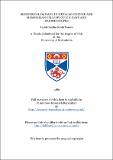Files in this item
Biophysical damage in metallo-enzyme and mammalian cells by Cu-K X-rays and radioisotopes
Item metadata
| dc.contributor.advisor | Watt, David E. | |
| dc.contributor.author | Younis, Abdul-Redha Sahib | |
| dc.coverage.spatial | 205 p. | en_US |
| dc.date.accessioned | 2018-06-14T15:39:44Z | |
| dc.date.available | 2018-06-14T15:39:44Z | |
| dc.date.issued | 1989 | |
| dc.identifier.uri | https://hdl.handle.net/10023/14089 | |
| dc.description.abstract | In the fields of radiobiology and nuclear medicine there is considerable interest in the important role played by Auger electron cascades caused by inner-shell ionisation in realistic risk. It is necessary to quantify this risk when radionuclides are used on a routine basis as investigative, diagnostic and radiotherapeutic tools, whether the applications involve incorporated electron capture radionuclides or K-shell ionisation of selected stable nuclides by X-rays, as in "photon activation therapy". Relevant published survival data on biological damage caused by the internal emitters 125I, 77Br, 3H, 33P, 131I and 32P which are incorporated into the DNA of mammalian cells, bacteria (E. Coli) and bacteriophages have been collected and the results re-analysed in terms of the parameters of a new damage model to determine an inactivation cross-section for each internal emitter. These quality parameters are the absolute specification of radiation quality and are compared with cross-sections similarly determined for the effects of external radiations from heavy charged particles and photons (chapter 2). The inactivation probabilities obtained for the nuclides 125I, 77Br and 3H extend over a wide range of values depending on the type of nuclide and its distribution, the type of sensitive target and its shape and distribution, and the environmental temperature during both irradiation and post-irradiation incubation. The higher values approach those determined for heavy charged particles with the same mean free path for primary ionisation, and are an order of magnitude larger than would be expected for external irradiation with photon generated electrons. The results for 33P, 131I and 32P nuclides are appreciably smaller than that expected for external irradiation since the long range electrons dissipate most of their energy out of the sensitive target. A theoretical equation for X-ray production by accelerated electrons incident on a thick target has been revised by including factors to compensate for backscattering, direct and indirect ionisation, attenuation in the target and the incident angle of electrons (chapter 3). An electron accelerator X-ray machine capable of delivering monoenergetic photons up to ~ 4.8 gray/sec exposure dose rate from four different targets has been designed, constructed and tested (chapter 4) The biophysical mechanisms of direct and indirect radiation action has also been studied using the metallo-enzyme dihydroorotic dehydrogenase. The enzyme was irradiated both in dry state and in solution at different concentrations and at different dose rates using monoenergetic Cu-K photons from our X-ray machine. A technique was developed whereby it was possible to isolate and quantify each type of radiation action (chapter 5). The inactivation of the enzyme in both solution and in dry state was found to be a single-hit/single-target process. It was also found that in solution the inactivation of the enzyme was dose-rate-and concentration-dependent with efficiency of radical inactivation has an exponential dependence on dose-rate and the inverse of the enzyme concentration. A new model for the inactivation of the enzyme has been suggested and its parameters, namely direct and indirect cross-sections, geometrical cross-section, saturated concentration constant, root mean square diffusion constant, mean free path of radicals absorption, life time and G value of radical production, have been determined. It is expected that this model can be generalised to suit other enzymes (chapter 6). | en_US |
| dc.language.iso | en | en_US |
| dc.publisher | University of St Andrews | |
| dc.subject.lcc | QH652.Y7 | en |
| dc.subject.lcsh | Radiobiology | en |
| dc.title | Biophysical damage in metallo-enzyme and mammalian cells by Cu-K X-rays and radioisotopes | en_US |
| dc.type | Thesis | en_US |
| dc.contributor.sponsor | Ministry of Higher Education and Scientific Research of the Republic of Iraq | en_US |
| dc.type.qualificationlevel | Doctoral | en_US |
| dc.type.qualificationname | PhD Doctor of Philosophy | en_US |
| dc.publisher.institution | The University of St Andrews | en_US |
This item appears in the following Collection(s)
Items in the St Andrews Research Repository are protected by copyright, with all rights reserved, unless otherwise indicated.

